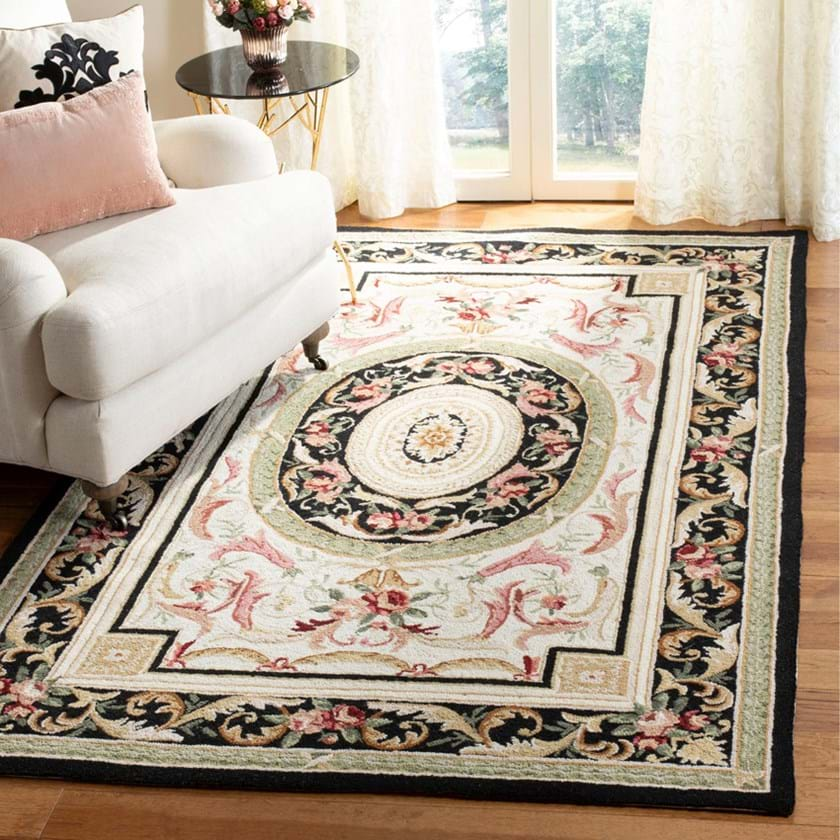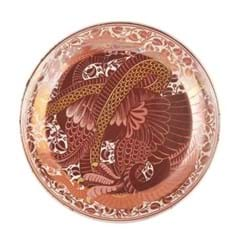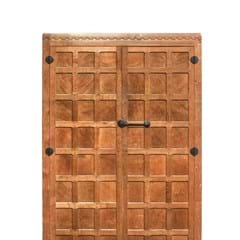A beginner’s guide to buying rugs and carpets
Origin, age, provenance, weave, colour and aesthetic value can all have an impact on the price of a rug or carpet at auction.
This modern Safavieh wool carpet from the Chelsea collection, 6ft x 9ft, sold at Pro Auction Ltd in March 2022.
Carpets and rugs are generally categorised by where and how they were woven. Antique rugs are most often woven from sheep and goat wool, cotton or silk, all of varying qualities.
Some of the most sought after are those made pre-1900s. These have historic appeal and all those made before the 1850 boast natural dyes (later ones often, but not always, do too). Natural dyes make for a richer tonal range than synthetic dyes, and these more vivid pieces are typically more desirable.
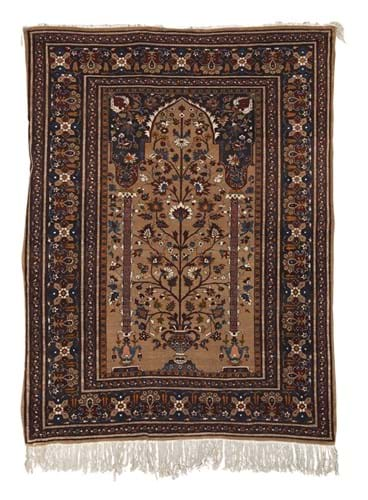
This modern Safavieh wool carpet from the Chelsea collection, 6ft x 9ft, sold at Pro Auction Ltd in March 2022.
Decorative value is sometimes determined by knot density (the number of knots in the pile) – the more loops, the more intricate the pattern will be. The two fundamental types of knots used to weave Oriental rugs are the Turkish (or Ghiordes or symmetrical knot) and the Persian knot (or Senneh or asymmetrical knock). Knotted rugs are known as ‘piled’, but rugs can also be flat-woven. These are known as kilims.
What’s in style?
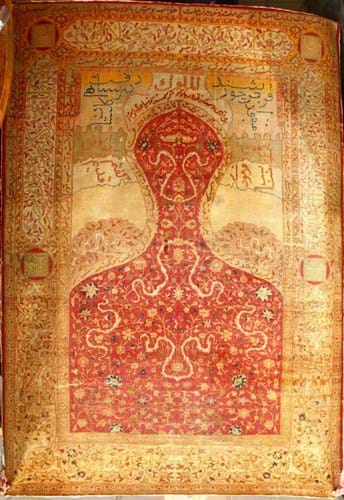
John Nicholson’s of Surrey hammered down this 17th or 18th century Persian Safavid style prayer rug for £4400 in March 2021. It featured calligraphy and floral scrolling decoration.
Recently tribal weavings, suzanis and even older carpets – those made before 1800 – have seen particular interest on the open market. However, hand-worked Persian rugs tend to lead the prices in this sector: the most expensive rug on record is a 17th century Persian rug that sold for $34m at a Sotheby’s New York auction in 2010.
Know your terms
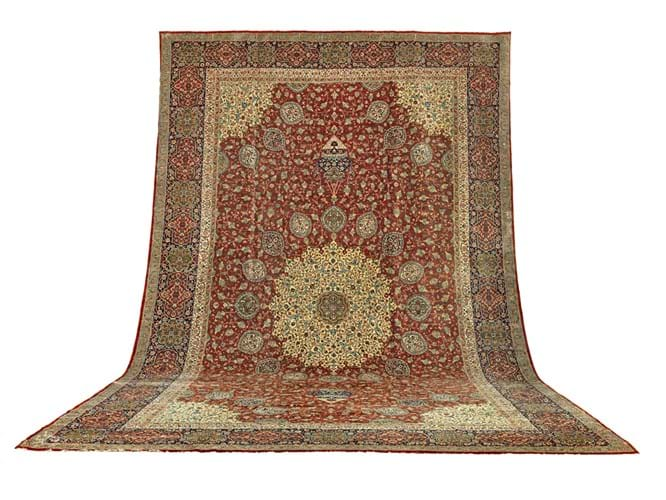
Bonhams offered this copy of the Ardabil carpet, a piece of Tabriz carpet from northwest Persia in December 2020. The famous original is displayed in the Victorian and Albert Museum and was made in north-west Iran. A British carpet dealer sold the carpet to the V&A in 1893 for £2000. This copy sold for £8000.
Often rugs are simply named from their place of origin and will have their own range of defining characteristics.
Some key terms to know in this field:
Abrash – from the Arabic word for mottled, denotes colour changes or striations running across the face of a rug
Arabesque – an ornate curving design of intertwined floral design
Court carpet – floor coverings handwoven under direction from the court, e.g. the Ottoman court
Field – the largest central area of a carpet
Hali – the Turkish word for carpet
Kilims – a flat tapestry-woven decorative rug produced in the countries of the former Persian Empire; regional examples include Chiprovtsi kilims from western Bulgaria and Prior kilims from southeastern Serbia.
Safavid Rugs – those made under the Safavid dynasty that ruled Iran until the early 18th century. These sophisticated urban pieces made use of Islamic designs. They often make use of a large central medallion in their design.

Adam’s of Dublin offered this 1940-50 Hereke Sivas Cezaevi measuring 2.94 x 1.98cm. This piece was woven by prisoners in Sivas, a city in central Turkey, and sold for €3000 in November 2022.
Rugs are often named for the place of their creation. For example, royal carpets were made for the Islamic courts while tribal carpets were made by nomadic tribespeople. Village and town rugs were made by artisans – often women – in larger settled groups. There are plenty of more specific terms for rug types (Agra, Navajo, Bokara, etc) to get into as you learn more about the topic.
Note that while much of what is discussed here refers to oriental rugs, there is a long history of rug making around the world.
Thinking about buying?
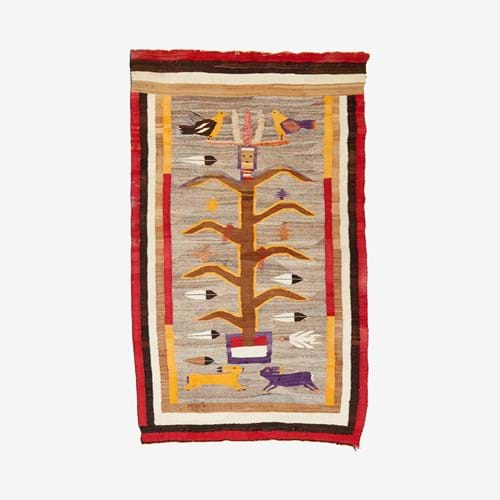
Sold for $1900 at Freeman’s of Philadelphia in September 2020, this is a 20th century Navajo pictorial Corn Yei rug.
If you’re springing for an antique rug, make sure you’re buying from a verified source. There are plenty of faux-antique works that may be falsely aged or painted rather than died.
Whether you’re buying modern, vintage or antique, however, you’ll want to consider several factors before springing for that beautiful floor covering.
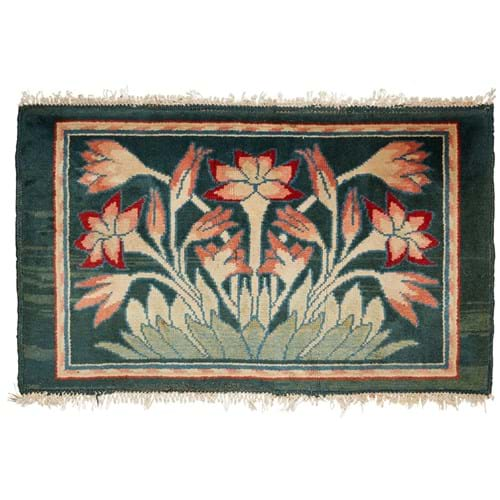
Morris & Co began large-scale production of floor coverings, rugs and carpets in 1875, at which time they were hailed as some of the finest of their kind ever produced in Britain. Morris’ designs grew so popular that more affordable patterns were in demand. These smaller pieces were often used as wall hanging or guest rugs, and several were produced for The Century Guild. This example, which is attributed to Herbert Horne for The Century Guild, sold for £7500 at Lyon & Turnbull in April 2021.
First, think about the size of the space you want to cover. There are plenty of interior design guides out there that will help you pick the right sized rug for your space. Size can often (but not always) be a big factor when it comes to cost. It’s worth noting that though today in western homes rugs are almost exclusively used as floor coverings, keep in mind that some of these pieces were originally used as wall hangings. That’s still an option as are other more creative items, such as upholstering furniture.

This George Smith three-seater sofa is upholstered with kilim and was sold for £8400 at Busby of Bridport in June 2021.
Second, what sort of maintenance will it require? It is possible to restore or conserve antique pieces, so if that’s something you think might be crucial to buying a certain piece, factor it into the budget.
Finally, what purpose will it serve? Some rugs will be naturally more hard-wearing than others. Consider colour, durability and warmth when choosing the right item for a particular room.
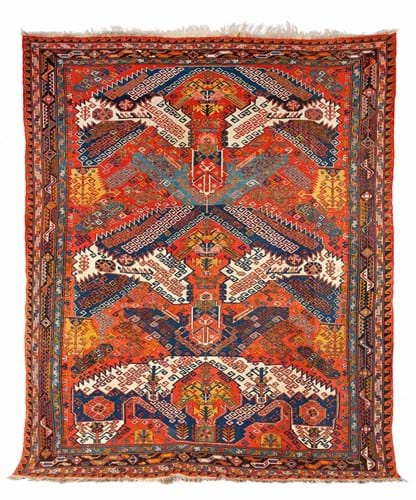
This hand-knotted wool Soumakh carpet, made in the Caucasus Mountains in the first half of the 19th century was offered from the Barcelona residence of the Sultan of Morocco. It was hammered down for €4000 at Stedart Subastas in Barcelona, February 2022.
Especially when considering antique rugs, prices can seem intimidating, but generally speaking there is something to suit every budget. Remember these are pieces that have often travelled far, seen many years of use, and were handmade by dedicated craftspeople.
What to do next
Decide how much you’d like to spend and use the search facility on thesaleroom.com to find rugs and carpets coming up for sale.
You can filter your search by, among other things, price and by location of the auction house to narrow down your selection.
To research recent prices at auction to see how much different rugs sold for you can also try out the Price Guide.
If you are new to bidding check out our guides to buying at auction – it’s easy once you know how.
